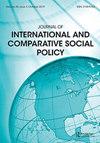北欧福利国家55-69岁死亡男女的收入保障
Q2 Social Sciences
Journal of International and Comparative Social Policy
Pub Date : 2019-03-19
DOI:10.1080/21699763.2019.1593877
引用次数: 5
摘要
当健康损害或其他社会风险发生时,收入保障是福利国家的主要目标。这项比较研究使用来自四个北欧福利国家的登记数据来检查55-69岁之间死亡的男性和女性在过去12年的等效可支配收入。分析的结果表明了一套不同的收入维持机制的总结果。芬兰、挪威和瑞典样本的收入中位数有所增加,但丹麦样本的收入中位数有所下降,这可能是由于相对频繁的退休过渡和退休后收入下降幅度大于其他北欧国家。通过倾向得分加权的比较样本分析表明,在观察期后存活的人比死亡的人收入发展更好。受教育程度较高的人在死亡前几年的收入发展比受教育程度较低的人更有利。本文章由计算机程序翻译,如有差异,请以英文原文为准。
Income security in Nordic welfare states for men and women who died when aged 55–69 years old
ABSTRACT Income security when health impairment or other social risks occur is a major objective of welfare states. This comparative study uses register data from four Nordic welfare states for examining equivalized disposable income during the last 12 years alive among men and women who died when aged 55–69 years old. The analysed outcome indicates the aggregate result of a varied set of income maintenance mechanisms. Median income increased in the Finnish, Norwegian and Swedish samples, but decreased somewhat in Denmark, probably due to relatively frequent transitions to retirement and larger income drops after retirement than in the other Nordic countries. Analyses of comparison samples weighted by propensity scores indicated a better income development among those who lived beyond the observation period than among those who died. The higher educated had a more favourable income development during the years prior to death than those with low education.
求助全文
通过发布文献求助,成功后即可免费获取论文全文。
去求助
来源期刊

Journal of International and Comparative Social Policy
Social Sciences-Sociology and Political Science
CiteScore
3.70
自引率
0.00%
发文量
18
 求助内容:
求助内容: 应助结果提醒方式:
应助结果提醒方式:


